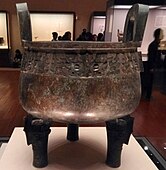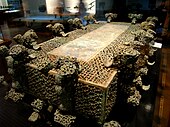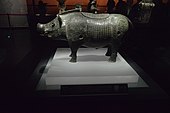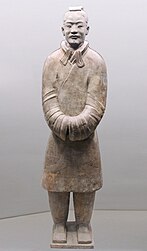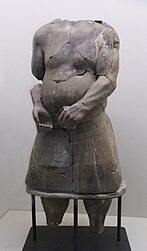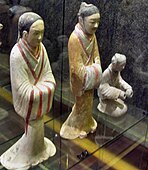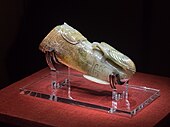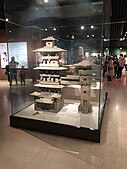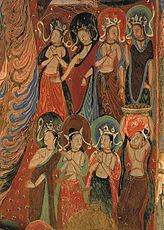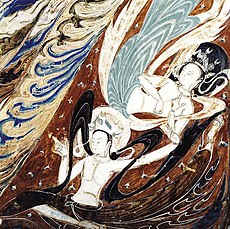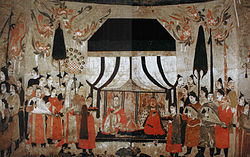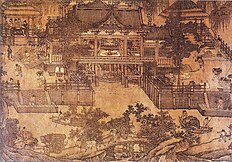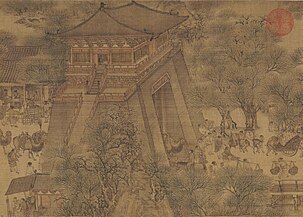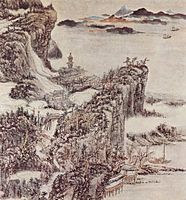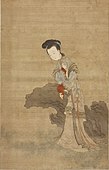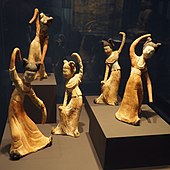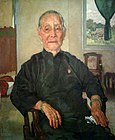Chinese art
This article needs additional citations for verification. (October 2023) |
| History of art |
|---|
| Part of a series on the |
| Culture of China |
|---|
 |
| Mythology and folklore |
| Cuisine |
| Festivals |
| Music and performing arts |
Chinese art is visual art that originated in or is practiced in China, Greater China or by Chinese artists. Art created by Chinese residing outside of China can also be considered a part of Chinese art when it is based on or draws on Chinese culture, heritage, and history. Early "Stone Age art" dates back to 10,000 BC, mostly consisting of simple pottery and sculptures. After that period, Chinese art, like Chinese history, was typically classified by the succession of ruling dynasties of Chinese emperors, most of which lasted several hundred years. The Palace Museum in Beijing and the National Palace Museum in Taipei contains extensive collections of Chinese art.[1][2]
Chinese art is marked by an unusual degree of continuity within, and consciousness of, tradition, lacking an equivalent to the Western collapse and gradual recovery of Western classical styles of art. Decorative arts are extremely important in Chinese art, and much of the finest work was produced in large workshops or factories by essentially unknown artists, especially in Chinese ceramics.
Much of the best work in ceramics, textiles, carved lacquer were produced over a long period by the various Imperial factories or workshops, which as well as being used by the court was distributed internally and abroad on a huge scale to demonstrate the wealth and power of the Emperors. In contrast, the tradition of ink wash painting, practiced mainly by scholar-officials and court painters especially of landscapes, flowers, and birds, developed aesthetic values depending on the individual imagination of and objective observation by the artist that are similar to those of the West, but long pre-dated their development there. After contacts with Western art became increasingly important from the 19th century onwards, in recent decades China has participated with increasing success in worldwide contemporary art.[citation needed]
History and development
[edit]Neolithic pottery
[edit]Early forms of art in China are found in the Neolithic Yangshao culture, which dates back to the 6th millennium BC. Archeological findings such as those at the Banpo have revealed that the Yangshao made pottery; early ceramics were unpainted and most often cord-marked. The first decorations were fish and human faces, but these eventually evolved into symmetrical-geometric abstract designs, some painted.[citation needed]
The most distinctive feature of Yangshao culture was the extensive use of painted pottery, especially human facial, animal, and geometric designs. Unlike the later Longshan culture, the Yangshao culture did not use pottery wheels in pottery making. Excavations have found that children were buried in painted pottery jars.[citation needed]
-
A red pot with two "ears"; by Peiligang culture; 6000–5200 BC; ceramic; Shanghai Museum
-
Dotted pottery pot, semi-mountain type; by Yangshao culture from China; 2700–2300 BCE; Gansu Provincial Museum (Lanzhou)
-
Jar; 2650–2350 BC; earthenware with painted decoration; height: 34 cm; Metropolitan Museum of Art (New York City)
-
Pot with geometric lattice pattern; by Majiayao culture; 2600–2300 BC; painted potter; Shanghai Museum
Jade culture
[edit]The Liangzhu culture was the last Neolithic Jade culture in the Yangtze River Delta and was spaced over a period of about 1,300 years. The Jade from this culture is characterized by finely worked, large ritual jades such as Cong cylinders, Bi discs, Yue axes and also pendants and decorations in the form of chiseled open-work plaques, plates and representations of small birds, turtles and fish. The Liangzhu Jade has a white, milky bone-like aspect due to its tremolite rock origin and influence of water-based fluids at the burial sites.[citation needed]
-
Cong, 3rd millennium BCE
-
Two-dragon ring, early Shang dynasty (2nd millennium BCE)
-
Jade dragon, Western Zhou
-
Rusted Zhou-era Jian with a jade hilt, c.9th century BCE
-
Chain of 16 carved jade pieces locked onto each other; 8th century BCE, Chu State.
Bronze casting
[edit]

The Bronze Age in China began with the Xia dynasty. Examples from this period have been recovered from ruins of the Erlitou culture, in Shanxi, and include complex but unadorned utilitarian objects. In the following Shang dynasty more elaborate objects, including many ritual vessels, were crafted. The Shang are remembered for their bronze casting, noted for its clarity of detail. Shang bronzesmiths usually worked in foundries outside the cities to make ritual vessels, and sometimes weapons and chariot fittings as well. The bronze vessels were receptacles for storing or serving various solids and liquids used in the performance of sacred ceremonies. Some forms such as the ku and jue can be very graceful, but the most powerful pieces are the ding, sometimes described as having an "air of ferocious majesty".[citation needed]
It is typical of the developed Shang style that all available space is decorated, most often with stylized forms of real and imaginary animals. The most common motif is the taotie, which shows a mythological being presented frontally as though squashed onto a horizontal plane to form a symmetrical design. The early significance of taotie is not clear, but myths about it existed around the late Zhou dynasty. It was considered to be variously a covetous man banished to guard a corner of heaven against evil monsters; or a monster equipped with only a head which tries to devour men but hurts only itself.
The function and appearance of bronzes changed gradually from the Shang to the Zhou. They shifted from being used in religious rites to more practical purposes. By the Warring States period, bronze vessels had become objects of aesthetic enjoyment. Some were decorated with social scenes, such as from a banquet or hunt; whilst others displayed abstract patterns inlaid with gold, silver, or precious and semiprecious stones.
Bronze artifacts also have significant meaning and roles in the Han dynasty as well. People used them for funerary purposes which reflect the aesthetic and artistic qualities of the Han dynasty.[5] Many bronze vessels excavated from tombs in Jiangsu Province, China, have various shapes like Ding, Hu, and Xun which represent traditional Chinese aesthete.[5] These vessels are classical representations of Chinese celestial art forms which play a great role in ancient Chinese's communication with spirits of their ancestors.[5] Other than the vessels, bronze weapons, daily items, and musical instruments are also found in royal Han families' tomb in Jiangsu. Being able to put a full set of Bianzhong in ones tomb signifies his or her status and class in the Han dynasty since this particular type of instrument is only acquired and owned by royal and wealth families.[5] Apparently, Bianzhong and music are also used as a path for the Han rulers to communication with their Gods.[5] The excavation of Bianzhong, a typical and royal instrument found in ancient China, emphasizes the development of complex music systems in the Han dynasty.[5] The set of Bianzhong can vary in many cases; for example, a specific excavation of Bianzhong from Jiangsu Province include different sets of bells, like Niuzhong and Yongzhong bells, and many of them appear in animal forms like the dragon, a traditional Chinese spiritual animal.[5]
Shang bronzes became appreciated as works of art from the Song dynasty, when they were collected and prized not only for their shape and design but also for the various green, blue green, and even reddish patinas created by chemical action as they lay buried in the ground. The study of early Chinese bronze casting is a specialized field of art history.
-
Sanxingdui bronze head, 2nd millennium BCE
-
Sacred bronze tree, Sanxingdui
-
Altar set; late 11th century BC; bronze; overall (table): height: 18.1 cm (71⁄8 in.), width: 46.4 cm (181⁄4 in.), depth: 89.9 cm (353⁄8 in.); Metropolitan Museum of Art (New York City, U.S.)
-
Square Lei, Shang dynasty, 2nd millennium BCE
-
Square zun with four sheep-head ornaments, Shang dynasty
-
Houmuwu ding, the largest ancient bronze ever found; 1300–1046 BCE; National Museum of China.
-
Ding with Taotie engravings from the late Shang, 2nd millennium BCE
-
Da He ding (大禾方鼎; Dà Hé fāngdǐng); Shang dynasty; Hunan Museum. This ritual bronze is one of the very rare vessels that is decorated with human faces
-
Taibao Ding from the Western Zhou, unearthed in Shandong; c. 10th century BCE
-
The Da Yu ding; 1054 BC (Western Zhou); height: 101.9 cm (40.1 in), width: 77.8 cm (30.6 in); discovered in 1849, Mei County, Shaanxi.
-
Da Ke ding; Western Zhou dynasty; height: 93.1 cm (36.7 in), width: 75.6 cm (29.8 in) (bore) & 74.9 cm (29.5 in) (inside diameter); discovered in 1890, at Famen Town (Fufeng County, Shaanxi); Shanghai Museum
-
Bell (lai zhong); 800–700 BC (Western Zhou dynasty); 70.3 × 37 × 26.6 cm (275⁄8 × 149⁄16 × 107⁄16 in.); from Meixian, Shaanxi); Cleveland Museum of Art. In ancient China music and ritual had political significance and were linked inseparably to the power of states
-
A bronze stand for ceremonial vessels; excavated from the tomb of the son of King Zhuang of Chu (r. 613–591 BCE)
-
Shi zun; 1600–1046 BC; height: 40 cm (16 in); discovered at Chuanxingshan (Xiangtan County, Hunan); Hunan Museum
Zhou dynasty (c. 1046 – 256 BCE)
[edit]During the Zhou period, few sculptures, especially sculptures of human or animal form, are recorded in the extant archaeology, and there does not appear to have been much of a sculptural tradition.[8][9] Among the very few such depictions known in China before that date: four wooden figurines[10] from Liangdaicun (梁帶村) in Hancheng (韓城), Shaanxi, possibly dating to the 9th century BCE; two wooden human figurines of foreigners possibly representing sedan chair bearers from a Qin state tomb in Longxian (隴縣), Shaanxi, from about 700 BCE; and more numerous statuettes from around 5th century bronze musicians in a miniature house from Shaoxing (紹興) in Zhejiang; a 4th-century human-shaped lamp stand from Pingshan (平山) county royal tomb, Hebei. The Taerpo horserider is a Zhou-era Warrior-State Qin terracotta figurine from a tomb in the Taerpo cemetery (塔兒坡墓) near Xianyang in Shaanxi, dated to the 4th–3rd century BCE. Another nearly-identical statuette is known, from the same tomb. Small holes in his hands suggest that he was originally holding reins in one hand, and a weapon in the other.[11] This is the earliest known representation of a cavalryman in China.[11]
-
Spring and Autumn period ox-shaped vessel, 6th century BCE
-
Silk painting depicting a man riding a dragon, 4th century BCE
-
Western Zhou, 11-9th century BCE
-
Gold sword hilt, Eastern Zhou
-
Silver belt buckle with inlaid gold and jade, Warring States, c. 4th century BCE
-
Bronze dui vessel with inlaid geometric cloud pattern, Eastern Zhou
Chu and Southern culture (c. 1030 BC – 223 BC)
[edit]
A rich source of art in early China was the state of Chu, which developed in the Yangtze River valley. Excavations of Chu tombs have found painted wooden sculptures, jade disks, glass beads, musical instruments, and an assortment of lacquerware. Many of the lacquer objects are finely painted, red on black or black on red. A site in Changsha, Hunan province, has revealed some of the oldest paintings on silk discovered to date.
-
Chu wares were elegant and sophisticated, they directly influenced later Han-era wares.
-
Heart-shaped lacquer box with phoenix pattern.
-
Painted lacquer box in the shape of 2 rear-to-rear pigs.
-
The Fenghuang was a popular motif in Chu art, whereas the dragon was more popular in the other states to its north.
-
Lacquer dou with phoenix base.
-
Lacquered yuren (羽人) figure on a toad stand
-
Small lacquered screen, Chu state, 5th century BCE
-
A lacquerware makeup case from the Jingmen Tomb
-
Close-up of the previous ware with intricate details of pre-imperial Hanfu
Early imperial China (221 BCE – 220 CE)
[edit]Qin art
[edit]The Terracotta Army, inside the Mausoleum of the First Qin Emperor, consists of more than 7,000 life-size tomb terracotta figures of warriors and horses buried with the self-proclaimed first Emperor of China Qin Shi Huang in 210–209 BC. The figures were painted before being placed into the vault. The original colors were visible when the pieces were first unearthed. However, exposure to air caused the pigments to fade, so today the unearthed figures appear terracotta in color. The figures are in several poses including standing infantry and kneeling archers, as well as charioteers with horses. Each figure's head appears to be unique, showing a variety of facial features and expressions as well as hair styles. The spectacular realism displayed by the sculptures is an evidence of the advancement of art during the Qin dynasty.[12] It is without precedent in the historical record of art in East Asia.[13][9]
A music instrument called Qin zither was developed during the Qin dynasty. The aesthetic components have always been as important as the functional parts on a musical instrument in Chinese history. The Qin zither has seven strings. Although Qin zither can sometimes remind people of corruptive history times, it is often considered as a delivery of peace and harmony.[14]
Han art
[edit]
During the Qin dynasty, Chinese font, measurement systems, currency were all standardized in order to bring further unification.[16] The Great Wall of China was expanded as a defensive construction against the northern intruders.[16]
The Han dynasty was known for jade burial suits. One of the earliest known depictions of a landscape in Chinese art comes from a pair of hollow-tile door panels from a Western Han dynasty tomb near Zhengzhou, dated 60 BCE.[17] A scene of continuous depth recession is conveyed by the zigzag of lines representing roads and garden walls, giving the impression that one is looking down from the top of a hill.[17] This artistic landscape scene was made by the repeated impression of standard stamps on the clay while it was still soft and not yet fired.[17] However, the oldest known landscape art scene tradition in the classical sense of painting is a work by Zhan Ziqian of the Sui dynasty (581–618).
Other than jade artifacts, bronze is another favorite medium for artists since it is hard and durable. Bronze mirrors have been mass-produced in the Han dynasty (206 BCE – 220 CE), and almost every tomb excavated that has been dated as Han dynasty has mirror in the burial.[18] The reflective side is usually made by a composition of bronze, copper, tin, and lead.[18] The word "mirror" means "to reflect" or "to look into" in Chinese, so bronze mirrors have been used as a trope for reflecting the reality.[18] The ancient Chinese believe that mirror can act as a representation of the reality, which could make them more aware of the current situation; also, mirrors are used as a media to convey or present a reflection of the past events.[18] The bronze mirrors made in the Han dynasty always have complex decorations on their non-reflective side; some of them consist narratives that tell stories.[18] The narratives themselves always reflect the common but essential theories to the Han people's lives.[19]
-
Glazed pottery dog, with collar patterned onto the surface; Eastern Han, 1st century CE.
-
Han dynasty lacquerwares were famed for their intricate and elegant designs.
-
Set of lacquered wine cups, with a typical pre-imperial design.
-
Cooler and ladle, Mawangdui
-
sericulture and silk embroidery reached a new high in the prosperous years of the Han
-
Abstract yet intricate patterns were found on coffins of lady Xin Zhui (217 BC–168 BC)
-
Delicate motifs relating to the afterlife are depicted around the meandering clouds on this inner coffin.
-
Banqueting figurines from Mawangdui, 2nd century BCE
-
Silk funerary banner, 2nd century BCE
-
Translucent silk was reserved for the highest of nobility as it was very difficult to produce.
-
Painted pottery pot with dragon and phoenix relief, as well as taotie designs for the lug handles.
-
Flying dragon from the Liu Fa tomb, Western Han
-
These figures represent guardian spirits of certain hours of the day- the left figure represents the first hour (midnight).
-
Han couple banquet together, from Luoyang c. 220 CE
-
A female servant and a male advisor in Han shenyi, terracotta figurines from Western Han.
-
Bronze statuette of a qilin, 1st century AD
-
Jade drinking vessel from Nannie, 1st century BCE
-
Western Han tomb fresco depicting the philosopher Confucius; 202 BCE – 9 CE; from Dongping County, Shandong
-
Two gentlemen engrossed in conversation while two others look on, a painting on a ceramic tile from a tomb near Luoyang, Henan, dated to the Eastern Han dynasty (25–220 AD)
-
pictorial brick depicting a courtyard, 2nd century BCE
-
Seals such as this one symbolised the authority of the kings and emperors of the Han.
-
A section of an Eastern Han (25–220 AD) fresco of 9 chariots, 50 horses, and over 70 men, from a tomb in Luoyang, China
-
Miniature model of a residential block. Recovered from a burial site.
-
A vast number of miniature models allows us an insight into the architectural styles of the day.
-
A golden belt buckle with dragon motif, Western Han
-
Mural of the Dahuting Tomb (打虎亭漢墓; Dáhǔtíng hàn mù) of the late Eastern Han, located in Zhengzhou, Henan
-
An Eastern Han ceramic figurine of a seated woman with a bronze mirror, unearthed from a tomb of Songjialin, Pi County, Sichuan
-
Heaves of silk with all sorts of intricate designs were found at Mawangdui.

First monumental stone sculptures (117 BCE)
[edit]
Terracotta statuettes had been known for a long time in China, but there are no known examples of monumental stone statuary before the stone sculptures at the Mausoleum of Huo Qubing (140–117 BCE), a general of Emperor Han Wudi who went to the western regions to fight the Xiongnu.[20] In literary sources, there is only a single 3rd–4th century CE record of a possible earlier example: two alleged monumental stone statues of qilin (Chinese unicorns) said have been set up on top of the tomb of the First Emperor Qin Shihuang.[21] The most famous of Huo Qubing's statues is that of a horse trampling a Xiongnu warrior.[20]
The Mausoleum of Huo Qubing (located in Maoling, the Mausoleum of Han Wudi) has 15 more stone sculptures. These are less naturalistic than the "Horse trampling a Xiongnu", and tend to follow the natural shape of the stone, with details of the figures only emerging in high-relief.[22] Following these early attempts, the usage of monumental stone statues would only develop from the end of the Western Han to the Eastern Han.[23]
Monumental stone statuary would become a major art form from the 4–6th centuries CE with the onset of monumental Buddhist sculpture in China.[24]
-
Crouching tiger, Huo Qubing Mausoleum
-
Horse Ready to Leap, Huo Qubing Mausoleum
-
Crouching boar. Huo Qubing Mausoleum
Period of division (220–581)
[edit]Influence of Buddhism
[edit]Buddhism arrived in China around the 1st century CE (although there are some traditions about a monk visiting China during Asoka's reign), and through to the 8th century it became very active and creative in the development of Buddhist art, particularly in the area of statuary. Receiving this distant religion, China soon incorporated strong Chinese traits in its artistic expression.
In the fifth to sixth century the Northern dynasties, rather removed from the original sources of inspiration, tended to develop rather symbolic and abstract modes of representation, with schematic lines. Their style is also said to be solemn and majestic. The lack of corporeality of this art, and its distance from the original Buddhist objective of expressing the pure ideal of enlightenment in an accessible, realistic manner, progressively led to a research towards more naturalism and realism, leading to the expression of Tang Buddhist art.
-
Mural from the Mogao caves, Western Wei, (535-556 A.D.)
-
Dunhuang mural, mid 6th century
-
Buddhist cave art, a dancer spins while the orchestra plays.
-
Vairocana, Longmen Grottoes, 500-900AD
-
An illustration of Sakyamuni's temptation by Mara
-
Reclining Buddha, High Tang period
Calligraphy
[edit]In ancient China, painting and calligraphy were the most highly appreciated arts in court circles and were produced almost exclusively by amateurs, aristocrats and scholar-officials who alone had the leisure to perfect the technique and sensibility necessary for great brushwork. Calligraphy was thought to be the highest and purest form of painting. The implements were the brush, made of animal hair, and black ink made from pine soot and animal glue. Writing as well as painting was done on silk. But after the invention of paper in the 1st century, silk was gradually replaced by the new and cheaper material. Original writings by famous calligraphers have been greatly valued throughout China's history and are mounted on scrolls and hung on walls in the same way that paintings are.
Wang Xizhi was a famous Chinese calligrapher who lived in the 4th century AD. His most famous work is the Lanting Xu, the preface to a collection of poems. The script was often celebrated as the high point of the semi-cursive "Running Style" in the history of Chinese calligraphy.
Wei Shuo was a well-known calligrapher of the Eastern Jin dynasty who established consequential rules about the regular script. Her well-known works include Famous Concubine Inscription (名姬帖 Ming Ji Tie) and The Inscription of Wei-shi He'nan (衛氏和南帖 Wei-shi He'nan Tie).
Painting
[edit]Gu Kaizhi is a celebrated painter of ancient China born in Wuxi. He wrote three books about painting theory: On Painting (畫論), Introduction of Famous Paintings of Wei and Jin Dynasties (魏晉名畫記) and Painting Yuntai Mountain (畫雲臺山記). He wrote, "In figure paintings the clothes and the appearances were not very important. The eyes were the spirit and the decisive factor." Three of Gu's paintings still survive today: Admonitions of the Instructress to the Court Ladies, Nymph of the Luo River (洛神賦), and Wise and Benevolent Women.
There are other examples of Jin dynasty painting from tombs. This includes the Seven Sages of the Bamboo Grove, painted on a brick wall of a tomb located near modern Nanjing and now found in the Shaanxi Provincial Museum. Each of the figures are labeled and shown either drinking, writing, or playing a musical instrument. Other tomb paintings also depict scenes of daily life, such as men plowing fields with teams of oxen.
-
Funerary panels, from the tomb of Sima Jinlong, 484 CE
-
A scene of two horseback riders from a wall painting in the tomb of Lou Rui at Taiyuan, Shanxi, Northern Qi dynasty (550–577)
-
Lotus-patterned vase from Northern Qi, 6th century CE
-
Lion-shaped candle holder from Western Jin c. 4th century CE
-
Northern Wei murals and painted figurines from the Yungang Grottoes, dated 5th to 6th centuries.
The Sui and Tang dynasties (581–960)
[edit]
Buddhist architecture and sculpture
[edit]Following a transition under the Sui dynasty, Buddhist sculpture of the Tang evolved towards a markedly lifelike expression. As a consequence of the dynasty's openness to foreign trade and influences through the Silk Road, Tang dynasty Buddhist sculpture assumed a rather classical form, inspired by the Greco-Buddhist art of Central Asia.
However, foreign influences came to be negatively perceived towards the end of the Tang dynasty. In the year 845, the Tang emperor Wuzong outlawed all "foreign" religions (including Nestorian Christianity, Zoroastrianism and Buddhism) in order to support indigenous Taoism. He confiscated Buddhist possessions and forced the faith to go underground, therefore affecting the ulterior development of the religion and its arts in China.
Glazed or painted earthenware Tang dynasty tomb figures are famous, and well-represented in museums around the world. Most wooden Tang sculptures have not survived, though representations of the Tang international style can still be seen in Nara, Japan. The longevity of stone sculpture has proved much greater. Some of the finest examples can be seen at Longmen, near Luoyang, Yungang near Datong, and Bingling Temple in Gansu. One of the most famous Buddhist Chinese pagodas is the Giant Wild Goose Pagoda, built in 652 AD.
-
Tang dynasty painting from Dunhuang.
-
Fresco from Dunhuang depicting typical Tang architecture
-
Painting of Varjapani
-
A Chinese Tang dynasty tri-color glazed porcelain horse (c. 700 AD), using yellow, green and white colors.
-
Central Asian influence can be seen in the shape of this cup.
Painting
[edit]
Beginning in the Tang dynasty (618–907), the primary subject matter of painting was the landscape, known as shanshui (mountain water) painting. In these landscapes, usually monochromatic and sparse, the purpose was not to reproduce exactly the appearance of nature but rather to grasp an emotion or atmosphere so as to catch the "rhythm" of nature.
Painting in the traditional style involved essentially the same techniques as calligraphy and was done with a brush dipped in black or colored ink; oils were not used. As with calligraphy, the most popular materials on which paintings were made were paper and silk. The finished works were then mounted on scrolls, which could be hung or rolled up. Traditional painting was also done in albums, on walls, lacquer work, and in other media.
Dong Yuan was an active painter in the Southern Tang Kingdom. He was known for both figure and landscape paintings, and exemplified the elegant style which would become the standard for brush painting in China over the next 900 years. As with many artists in China, his profession was as an official where he studied the existing styles of Li Sixun and Wang Wei. However, he added to the number of techniques, including more sophisticated perspective, use of pointillism and crosshatching to build up vivid effect.
Zhan Ziqian was a painter during the Sui dynasty. His only painting in existence is Strolling About In Spring arranged mountains perspectively. Because pure landscape paintings are hardly seen in Europe until the 17th century, Strolling About In Spring may well be the world's first landscape painting.

The Song and Yuan dynasties (960–1368)
[edit]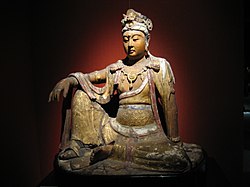

Song painting
[edit]During the Song dynasty (960–1279), landscapes of more subtle expression appeared; immeasurable distances were conveyed through the use of blurred outlines, mountain contours disappearing into the mist, and impressionistic treatment of natural phenomena. Emphasis was placed on the spiritual qualities of the painting and on the ability of the artist to reveal the inner harmony of man and nature, as perceived according to Taoist and Buddhist concepts.
Liang Kai was a Chinese painter who lived in the 13th century (Song dynasty). He called himself "Madman Liang", and he spent his life drinking and painting. Eventually, he retired and became a Zen monk. Liang is credited with inventing the Zen school of Chinese art. Wen Tong was a painter who lived in the 11th century. He was famous for ink paintings of bamboo. He could hold two brushes in one hand and paint two different distanced bamboos simultaneously. He did not need to see the bamboo while he painted them because he had seen a lot of them.
Zhang Zeduan was a notable painter for his horizontal Along the River During the Qingming Festival landscape and cityscape painting. It is considered one of China's most renowned paintings and has had many well-known remakes throughout Chinese history.[25] Other famous paintings include The Night Revels of Han Xizai, originally painted by the Southern Tang artist Gu Hongzhong in the 10th century, while the well-known version of his painting is a 12th-century remake of the Song dynasty. This is a large horizontal handscroll of a domestic scene showing men of the gentry class being entertained by musicians and dancers while enjoying food, beverage, and wash basins provided by maidservants. In 2000, the modern artist Wang Qingsong created a parody of this painting with a long, horizontal photograph of people in modern clothing making similar facial expressions, poses, and hand gestures as the original painting.

-
Buddhist Temple in the Mountains, 11th century, ink on silk, Nelson-Atkins Museum of Art, Kansas City (Missouri).
-
Seated Bodhisattva Avalokitesvara (Guanyin), wood and pigment, 11th century, Chinese Northern Song dynasty, St. Louis Art Museum
-
Almanac of birds and beasts, typical example of the Gongbi styles popular during the Song
-
Three Friends of Winter depicting plum, pine and bamboo, still used for decoration during new year's by countries in the sinosphere
-
Traveling on the River in Snow. Extremely intricate details give historians insight into medieval Chinese shipbuilding.
-
Emperor Huizong of Song was a prolific painter
-
Li Anzhong's Bird on a Branch; it has a circular shape because this was initially painted for a circular fan.
-
Loquats and a Mountain Bird, Southern Song (1127–1279); small album leaf paintings like this were popular amongst gentry and scholar-officials.
-
Auspicious Cranes, by Emperor Huizong depicting a scene on top of Kaifeng city gate on 16 January 1112.
-
The Spring Tide Brings Rain by Li Di
-
Circular-fan painting by Ma Lin
-
Shrike on a tree in winter; 1187 AD.
-
Wintry Sparrows by Cui Bai
-
Travelers among Mountains and Streams (谿山行旅), Fan Kuan (c. 960 – 1032)
-
"One Hundred Children Playing in the Spring" by Su Hanchen((1094–1172))
-
The Knickknack Peddler by Su Hanchen; depictions of common life became a popular motif during the prosperous years of the Song dynasty
Yuan painting
[edit]
With the fall of the Song dynasty in 1279, and the subsequent dislocation caused by the establishment of the Yuan dynasty by the Mongol conquerors, many court and literary artists retreated from social life, and returned to nature, through landscape paintings, and by renewing the "blue and green" style of the Tang era.[26]
Wang Meng was one such painter, and one of his most famous works is the Forest Grotto. Zhao Mengfu was a Chinese scholar, painter and calligrapher during the Yuan dynasty. His rejection of the refined, gentle brushwork of his era in favor of the cruder style of the 8th century is considered to have brought about a revolution that created the modern Chinese landscape painting. There was also the vivid and detailed works of art by Qian Xuan (1235–1305), who had served the Song court, and out of patriotism refused to serve the Mongols, instead turning to painting. He was also famous for reviving and reproducing a more Tang dynasty style of painting.
The later Yuan dynasty is characterized by the work of the so-called "Four Great Masters". The most notable of these was Huang Gongwang (1269–1354) whose cool and restrained landscapes were admired by contemporaries, and by the Chinese literati painters of later centuries. Another of great influence was Ni Zan (1301–1374), who frequently arranged his compositions with a strong and distinct foreground and background, but left the middle-ground as an empty expanse. This scheme was frequently to be adopted by later Ming and Qing dynasty painters.[26]
Pottery
[edit]Chinese porcelain is made from a hard paste made of the clay kaolin and a feldspar called petuntse, which cements the vessel and seals any pores. China has become synonymous with high-quality porcelain. Most china pots comes from the city of Jingdezhen in Jiangxi province. Jingdezhen porcelain, under a variety of names, has been central to porcelain production in China since at least the Yuan dynasty.
Late imperial China (1368–1912)
[edit]Ming painting
[edit]Under the Ming dynasty, Chinese culture bloomed. Narrative painting, with a wider color range and a much busier composition than the Song paintings, was immensely popular during the time.
Wen Zhengming (1470–1559) developed the style of the Wu school in Suzhou, which dominated Chinese painting during the 16th century.[27]
Dong Qichang (1555–1636) further influenced East Asian art history by absorbing Chan Buddhism ideas and putting forward the "Southern and Northern Schools" theory.[28]
European culture began to make an impact on Chinese art during this period. The Jesuit priest Matteo Ricci visited Nanjing with many Western artworks, which were influential in showing different techniques of perspective and shading.[29]
-
Bian Jingzhao's intricate Gongbi took after the styles of Song, whilst incorporating other artistic styles
-
Three Friends and a Hundred Birds, zoom in to see the details.
-
Ming Empress phoenix crown, decorated with Tian-tsui.
-
Tang Yin's A Fisher in Autumn
-
Peach Festival of the Queen Mother of the West, early 17th century, Ming dynasty.
-
Bian Jingzhao's Snow Plum and Twin Cranes incorporating the Gonbi style, 15th century.
-
Emperor Shenzong and Empress Xiaoduan
-
Bird Peddler, 16th century. The prosperity of the Ming-era inspired a renaissance in art depicting common life.
-
Water and Land Ritual painting of Canshen and the Five Demons of Pestilence, Baoning Temple, Ming dynasty
-
Magnolia and Erect Rock (玉堂柱石圖)
-
Ming portraiture also took after Song styles, however it shed its adherence to plainness and austerity.
-
Detail of The Emperor's Approach showing the Wanli Emperor's royal carriage being pulled by elephants and escorted by cavalry (full panoramic painting here)
Early Qing painting
[edit]The early Qing dynasty developed in two main strands: the Orthodox school, and the Individualist painters, both of which followed the theories of Dong Qichang, but emphasizing very different aspects.[30] Court painting of the Qing dynasty was also greatly influenced by Western artists such as Jean Denis Attiret (1702–1768) and Giuseppe Castiglione (1688–1766).[28]
The "Four Wangs", including Wang Jian (1598–1677) and Wang Shimin (1592–1680), were particularly renowned in the Orthodox school, and sought inspiration in recreating the past styles, especially the technical skills in brushstrokes and calligraphy of ancient masters. The younger Wang Yuanqi (1642–1715) ritualized the approach of engaging with and drawing inspiration from a work of an ancient master. His own works were often annotated with his theories of how his painting relates to the master's model.[31]
The Individualist painters included Bada Shanren (1626–1705) and Shitao (1641–1707). They drew more from the revolutionary ideas of transcending the tradition to achieve an original individualistic styles; in this way they were more faithfully following the way of Dong Qichang than the Orthodox school (who were his official direct followers.)[32]
Painters outside of the literati-scholar and aristocratic traditions also gained renown, with some artists creating paintings to sell for money. These included Ma Quan (late 17th–18th century), who depicted common flowers, birds, and insects that were not typical subject matter among scholars. Such painters were, however, not separated from formal schools of painting, but were usually well-versed in artistic styles and techniques. Ma Quan, for example, modelled her brushwork on Song dynasty examples.[33] Simultaneously, the boneless technique (Chinese: 沒骨畫), thought to have originated as a preparatory step when painting gold-line images during the Tang, was continued by painters like Yun Shouping (1633–1690) and his descendant Yun Bing.[34]
As the techniques of color printing were perfected, illustrated manuals on the art of painting began to be published. Jieziyuan Huazhuan (Manual of the Mustard Seed Garden), a five-volume work first published in 1679, has been in use as a technical textbook for artists and students ever since.
-
The Yongzheng Emperor Enjoying Himself During the 8th Lunar Month, by anonymous court artists, 1723–1735 AD, Palace Museum, Beijing, showing the use of linear perspective.
-
Album Leaf, Yun Bing, 17th century, Metropolitan Museum of Art, New York, showing the "boneless" technique.
-
Chinese painting from 1664 by Qing dynasty painter Kun Can
Late Qing art
[edit]Nianhua were a form of colored woodblock prints in China, depicting images for decoration during the Chinese New Year. In the 19th century Nianhua were used as news mediums.
Shanghai School
[edit]The Shanghai School is a very important Chinese school of traditional arts during the Qing dynasty and the 20th century. Under efforts of masters from this school, traditional Chinese art reached another climax and continued to the present in forms of Chinese painting (中國畫), or guohua (國畫) for short. The Shanghai School challenged and broke the literati tradition of Chinese art, while also paying technical homage to the ancient masters and improving on existing traditional techniques. Members of this school were themselves educated literati who had come to question their very status and the purpose of art, and had anticipated the impending modernization of Chinese society. In an era of rapid social change, works from the Shanghai School were widely innovative and diverse, and often contained thoughtful yet subtle social commentary. The best known figures from this school are Ren Xiong, Ren Bonian, Zhao Zhiqian, Wu Changshuo, Sha Menghai, Pan Tianshou, Fu Baoshi, He Tianjian, and Xie Zhiliu. Other well-known painters include Wang Zhen, Xugu, Zhang Xiong, Hu Yuan, and Yang Borun.
Painting
[edit]
Traditional Chinese painting, like Chinese calligraphy, is done with a brush dipped in black or colored ink; oils are not used. As with calligraphy, the most popular materials on which paintings are made of are paper and silk. The finished work can be mounted on scrolls, such as hanging scrolls or handscrolls. Traditional painting can also be done on album sheets, walls, lacquerware, folding screens, and other media.
The two main techniques in Chinese painting are:
- Gong-bi (工筆), meaning "meticulous", uses highly detailed brushstrokes that delimits details very precisely. It is often highly coloured and usually depicts figural or narrative subjects. It is often practised by artists working for the royal court or in independent workshops. Bird-and-flower paintings were often in this style.
- Ink and wash painting, in Chinese Shui-mo or (水墨[35]) also loosely termed watercolour or brush painting, and also known as "literati painting", as it was one of the "four arts" of the Chinese Scholar-official class.[36] In theory this was an art practised by gentlemen, a distinction that begins to be made in writings on art from the Song dynasty, though in fact the careers of leading exponents could benefit considerably.[37] This style is also referred to as "xie yi" (寫意) or freehand style.
Artists from the Han to the Tang dynasties mainly painted the human figure. Much of what is known of early Chinese figure painting comes from burial sites, where paintings were preserved on silk banners, lacquered objects, and tomb walls. Many early tomb paintings were meant to protect the dead or help their souls get to paradise. Others illustrated the teachings of the Chinese philosopher Confucius, or showed scenes of daily life. Most Chinese portraits showed a formal full-length frontal view, and were used in the family in ancestor veneration. Imperial portraits were more flexible, but were generally not seen outside the court, and portraiture formed no part of Imperial propaganda, as in other cultures.
Many critics consider landscape to be the highest form of Chinese painting. The time from the Five Dynasties period to the Northern Song period (907–1127) is known as the "Great age of Chinese landscape". In the north, artists such as Jing Hao, Li Cheng, Fan Kuan, and Guo Xi painted pictures of towering mountains, using strong black lines, ink wash, and sharp, dotted brushstrokes to suggest rough rocks. In the south, Dong Yuan, Juran, and other artists painted the rolling hills and rivers of their native countryside in peaceful scenes done with softer, rubbed brushwork. These two kinds of scenes and techniques became the classical styles of Chinese landscape painting.
-
Early Autumn; by Qian Xuan; 13th century; ink and colors on paper scroll; 26.7 × 120.7 cm; Detroit Institute of Arts. The decaying lotus leaves and dragonflies hovering over stagnant water are probably a veiled criticism of Mongol rule[38]
-
Lohan manifesting himself as an eleven-headed Guanyin; circa 1178; ink and color on silk; 111.5 × 53.1 cm; Museum of Fine Arts, Boston
-
Parrot and insect among pear blossoms; by Huang Jucai; second half of the 13th century; ink and colour on silk; 27.6 × 27.6 cm; Museum of Fine Arts (Boston)
-
Wang Xizhi watching geese; by Qian Xuan; 1235 – before 1307; handscroll (ink, color and gold on paper); Metropolitan Museum of Art (New York City)
-
The eight hosts of Deva, Naga and Yakshi; 1454; hanging scroll, ink and color on silk; dimensions of the painting: 140.2 × 78.8 cm; Cleveland Museum of Art
-
Portrait of Zhu Youjiao; after 1620; painting; National Palace Museum, Taipei
-
Landscape, part of an album of eight leaves; by Lu Han; 1699; ink and color on paper; image: 30.5 × 22.9 cm; Metropolitan Museum of Art
-
Another landscape, part of the same album of eight leaves; by Lu Han; 1699; ink and color on paper; image: 30.5 × 22.9 cm; Metropolitan Museum of Art
-
Landscape; by Dong Yuan; turn of the 18/19th century; handscroll, ink on silk; 39.1 × 717.6 cm; Metropolitan Museum of Art
-
Portrait; early 20th century (?); album of twenty leaves, ink and color on silk; 28.3 × 22.2 cm; Metropolitan Museum of Art
-
Chinese Painting – Traveling on the Road.
-
Northern Song dynasty-Finches and bamboo
-
Strolling About in Spring, by Zhan Ziqian, artist of the Sui dynasty (581–618).
-
Court Ladies of the Former Shu by Tang Yin
-
Tang Yin – The Gathering at the Orchid Pavilion
-
Tang Yin – A beauty – Rhode Island School of Design Museum
-
Tang Yin – Making the Bride's Gown – Walters
-
Brooklyn Museum – The Chinese Buddhist Pilgrim Xuanzang
-
China, Qing dynasty – Portrait of Buddhist Monks of Obaku Sect – Cleveland Museum of Art
Sculpture
[edit]Chinese ritual bronzes from the Shang and Western Zhou dynasties come from a period of over a thousand years from c. 1500 BC, and have exerted a continuing influence over Chinese art. They are cast with complex patterned and zoomorphic decoration, but avoid the human figure, unlike the huge figures only recently discovered at Sanxingdui.[39] The spectacular Terracotta Army was assembled for the tomb of Qin Shi Huang, the first emperor of a unified China from 221 to 210 BC, as a grand imperial version of the figures long placed in tombs to enable the deceased to enjoy the same lifestyle in the afterlife as when alive, replacing actual sacrifices of very early periods. Smaller figures in pottery or wood were placed in tombs for many centuries afterwards, reaching a peak of quality in the Tang dynasty tomb figures.[40]
Native Chinese religions do not usually use cult images of deities, or even represent them, and large religious sculpture is nearly all Buddhist, dating mostly from the 4th to the 14th century, and initially using Greco-Buddhist models arriving via the Silk Road. Buddhism is also the context of all large portrait sculpture; in total contrast to some other areas in medieval China even painted images of the emperor were regarded as private. Imperial tombs have spectacular avenues of approach lined with real and mythological animals on a scale matching Egypt, and smaller versions decorate temples and palaces.[41] Small Buddhist figures and groups were produced to a very high quality in a range of media,[42] as was relief decoration of all sorts of objects, especially in metalwork and jade.[43] Sculptors of all sorts were regarded as artisans and very few names are recorded.[44]
-
Ritual tripod cauldron (ding); circa 13th century BC; bronze: height with handles: 25.4 cm; Metropolitan Museum of Art (New York City)
-
Wine vase (zun); 13th century BCE; bronze inlaid with black pigment; height: 40 cm; Metropolitan Museum of Art
-
One of the warriors of the Terracotta Army, a famous collection of terracotta sculptures depicting the armies of Qin Shi Huang, the first Emperor of China
-
Changxin Palace lamp; circa 172 BCE; bronze and gold; height: 48 cm; Hebei Provincial Museum (China); excavated from the tomb of Dou Wan
-
The Flying Horse of Gansu; circa 300; bronze; height: 34.5 cm, length: 45 cm; width: 13.1 cm; Gansu Provincial Museum, Lanzhou
-
Votive stele with Buddha Shakyamuni; dated 542 (Eastern Wei dynasty); limestone; Museum Rietberg (Zürich, Switzerland)
-
Sculpture probably of Amitābha; early 7th century; hollow dry lacquer with traces of gilt and polychrome pigment and gilding; height: 96.5 cm, width: 68.6 cm, depth: 57.1 cm; Metropolitan Museum of Art
-
The Leshan Giant Buddha, a 71 m tall stone statue, built between 713 and 803, Tang dynasty
-
Statue of a monk; 8th century; limestone with pigment; limestone with pigment; height (including the stone dowel): 175.3 cm; Metropolitan Museum of Art
-
Statue of the luohan Tamrabhadra, one of the group of glazed pottery luohans from Yixian; 10th–13th century; glazed terracotta; height: 123 cm; Guimet Museum (Paris)
-
Bodhisattva Avalokiteshvara in water moon form (Shuiyue Guanyin); 11th century; wood (willow) with traces of pigment, multiple-woodblock construction; height: 118.1 cm, width: 95.3 cm, depth: 71.1 cm; Metropolitan Museum of Art
-
Seated luohan; 18th–19th century; lapis lazuli; height: 18.1 cm, width: 25.4 cm; Metropolitan Museum of Art
Ceramics
[edit]Chinese ceramic ware shows a continuous development since the pre-dynastic periods, and is one of the most significant forms of Chinese art. China is richly endowed with the raw materials needed for making ceramics. The first types of ceramics were made during the Palaeolithic era, and in later periods range from construction materials such as bricks and tiles, to hand-built pottery vessels fired in bonfires or kilns, to the sophisticated Chinese porcelain wares made for the imperial court. Most later Chinese ceramics, even of the finest quality, were made on an industrial scale, thus very few individual potters or painters are known. Many of the most renowned workshops were owned by or reserved for the Emperor, and large quantities of ceramics were exported as diplomatic gifts or for trade from an early date.
-
Tomb guardian; early 700s; glazed earthenware, sancai (three-color) ware; Cleveland Museum of Art
-
Statuettes of dancers; 8th century; ceramic; Historical Museum of Bern (Switzerland)
-
The David Vases; 1351 (the Yuan dynasty); porcelain, cobalt blue decor under glaze; height: 63.8 cm; British Museum (London)
-
Two flasks with dragons; 1403–1424; underglaze blue porcelain; height (the left one): 47.8 cm, height (the right one): 44.6 cm; British Museum
-
Buddhist figurines; by Qiao Bin; circa 1503; glazed pottery; various dimensions; Metropolitan Museum of Art
-
Figure of an assistant to the Judge of Hell decorated in polychrome enamels with cold-painted details; 1522–1620; painted and glazed earthenware; height: 136 cm, width: 39 cm; British Museum
-
An assistant to the Judge of Hell, figure from a judgement group; 16th century; glazed earthenware and painted decoration; height: 148 cm, width: 36 cm, depth: 20 cm; British Museum
-
Jar: 18th century; porcelain painted in overglaze famille rose enamels; height: 61 cm; Metropolitan Museum of Art (New York City)
-
Vase; last quarter 18th century; porcelain with openwork medallions, painted in overglaze famille rose enamels, with engraved design: height: 29.8 cm, diameter: 19.1 cm; Metropolitan Museum of Art
-
Vase with cover; 1662–1722; porcelain with underglaze blue decoration; overall: 46.2 cm; Cleveland Museum of Art
-
Republic of China period Porcelain Vase
-
early Yaozhou ware from the Five Dynasties period, 10th century AD
-
Chinese Porcelain Ewer, 17th century
-
Chinese Porcelain Guanyin, 17th–18th century
-
Chinese vase, Ming dynasty, porcelain with celadon glaze
-
Erotic Chinese porcelain plate
-
12th century; from the southern Song dynasty.
-
Jin Porcelain Pillow
-
Qing Tablet with Map of Imperial Porcelain Factory
Decorative arts
[edit]As well as porcelain, a wide range of materials that were more valuable were worked and decorated with great skill for a range of uses or just for display.[43] Chinese jade was attributed with magical powers, and was used in the Stone and Bronze Ages for large and impractical versions of everyday weapons and tools, as well as the bi disks and cong vessels.[45] Later a range of objects and small sculptures were carved in jade, a difficult and time-consuming technique. Bronze, gold and silver, rhinoceros horn, Chinese silk, ivory, lacquer and carved lacquer, cloisonne enamel and many other materials had specialist artists working in them. Cloisonne underwent an interesting process of artistic hybridization in China, particularly in the pieces promoted by missionaries and Chinese Christian communities.[46]
Folding screens (Chinese: 屏風; pinyin: píngfēng) are often decorated with beautiful art; major themes include mythology, scenes of palace life, and nature. Materials such as wood panel, paper and silk are used in making folding screens. They were considered ideal ornaments for many painters to display their paintings and calligraphy.[47][48] Many artists painted on paper or silk and applied it onto the folding screen.[47] There were two distinct artistic folding screens mentioned in historical literature of the era.
-
Covered box with pavilion and figures; 1300s (the Yuan dynasty); carved lacquer; Tokyo National Museum
-
Chinese low-back armchair; late 16th–18th century (late Ming dynasty to Qing dynasty); huanghuali rosewood; Arthur M. Sackler Gallery, Washington D.C.
-
Cup; early 17th century; rhinoceros horn; height: 10.2 cm; Metropolitan Museum of Art
-
Folding screen; circa 1690; lacquered wood and paper; Calouste Gulbenkian Museum, Lisbon
-
Plate; late 17th–early 18th century; cloisonné enamel; height: 4.4 cm, diameter: 25.7 cm; Metropolitan Museum of Art
-
Incense burner in the shape of a rooster; 18th century; cloisonné enamel on copper; height: 19.4 cm; Metropolitan Museum of Art
-
Vase; 18th century; cloisonné enamel; height: 36.8 cm, width: 17.8 cm; Metropolitan Museum of Art
-
Chinese moon-gate bed; circa 1876; satinwood (huang lu), other Asian woods and ivory; Peabody Essex Museum (Salem, Massachusetts)
Architecture
[edit]
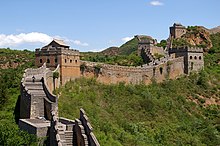
Chinese architecture refers to a style of architecture that has taken shape in East Asia over many centuries. Especially Japan, Korea, Vietnam and Ryukyu. The structural principles of Chinese architecture have remained largely unchanged, the main changes being only the decorative details. Since the Tang dynasty, Chinese architecture has had a major influence on the architectural styles of Korea, Vietnam, and Japan.
From the Neolithic era Longshan culture and Bronze Age era Erlitou culture, the earliest rammed earth fortifications exist, with evidence of timber architecture. The subterranean ruins of the palace at Yinxu dates back to the Shang. In historic China, architectural emphasis was laid upon the horizontal axis, in particular the construction of a heavy platform and a large roof that floats over this base, with the vertical walls not as well emphasized. This contrasts Western architecture, which tends to grow in height and depth. Chinese architecture stresses the visual impact of the width of the buildings. The deviation from this standard is the tower architecture of the Chinese tradition, which began as a native tradition[citation needed] and was eventually influenced by the Buddhist building for housing religious sutras—the stupa—which came from Nepal. Ancient Chinese tomb model representations of multiple story residential towers and watchtowers date to the Han. However, the earliest extant Buddhist Chinese pagoda is the Songyue Pagoda, a 40 m (131 ft) tall circular-based brick tower built in Henan in the year 523 CE From the 6th century onwards, stone-based structures become more common, while the earliest are from stone and brick arches found in Han dynasty tombs. The Zhaozhou Bridge built from 595 to 605 CEis China's oldest extant stone bridge, as well as the world's oldest fully stone open-spandrel segmental arch bridge.
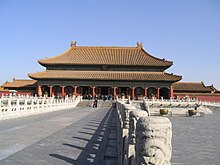
The vocational trade of architect, craftsman, and engineer was not as highly respected in premodern Chinese society as the scholar-bureaucrats who were drafted into the government by the civil service examination system. Much of the knowledge about early Chinese architecture was passed on from one tradesman to his son or associative apprentice. However, there were several early treatises on architecture in China, with encyclopedic information on architecture dating back to the Han dynasty. The height of the classical Chinese architectural tradition in writing and illustration can be found in the Yingzao Fashi, a building manual written by 1100 and published by Li Jie (1065–1110) in 1103. In it there are numerous and meticulous illustrations and diagrams showing the assembly of halls and building components, as well as classifying structure types and building components.
There were certain architectural features that were reserved solely for buildings built for the Emperor of China. One example is the use of yellow roof tiles; yellow having been the Imperial color, yellow roof tiles still adorn most of the buildings within the Forbidden City. The Temple of Heaven, however, uses blue roof tiles to symbolize the sky. The roofs are almost invariably supported by brackets, a feature shared only with the largest of religious buildings. The wooden columns of the buildings, as well as the surface of the walls, tend to be red in colour.
Many current Chinese architectural designs follow post-modern and western styles.
-
Relief from the Wu Family Shrines (Jiaxiang County, Shandong) that shows Han dynasty architecture, 151 CE
-
The Guanyian Pavilion of the Dule Monastery (Jixian, China), 984
-
The Songyue Pagoda, Henan, 523
-
Hall of Prayer for Good Harvests, the main building of the Temple of Heaven (Beijing), 1703–1790
-
The Longxing Temple in Hebei (Zhengding, China), 1052
-
Pagoda of Fogong Temple, Shanxi, 1056
-
The Dacheng Hall of the Temple of Confucius Qufu, Shandong, 1499
Chinoiserie
[edit]Chinoiserie is the European interpretation and imitation of Chinese and East Asian artistic traditions, especially in the decorative arts, garden design, architecture, literature, theatre, and music.[49] The aesthetic of Chinoiserie has been expressed in different ways depending on the region. It is related to the broader current of Orientalism, which studied Far East cultures from a historical, philological, anthropological, philosophical, and religious point of view. First appearing in the 17th century, this trend was popularized in the 18th century due to the rise in trade with China and East Asia.[50]
As a style, chinoiserie is related to the rococo style.[51] Both styles are characterized by exuberant decoration, asymmetry, a focus on materials, and stylized nature and subject matter that focuses on leisure and pleasure. Chinoiserie focuses on subjects that were thought by colonial-era Europeans to be typical of Chinese culture.
-
Kneehole writing table; circa 1760; mahogany, mahogany veneer and gilt bronze; 88.9 × 97.8 × 62.2 cm; Metropolitan Museum of Art (New York City)
-
Audience of the Chinese Emperor; 1766; hard-paste porcelain; overall: 39.8 × 33.2 × 21.7 cm; Metropolitan Museum of Art
-
Drop-front secretaire (secrètaire à abattant); 1770–1775; painted and varnished oak, mahogany, purplewood and gilt-bronze mounts; 152.4 × 67.9 × 34 cm; Metropolitan Museum of Art
-
Ornamental Design from "Nouvelle suite de cahiers chinois a l'usage des Dessinateurs et des peintres"; after 1775; etching with colored inks à la poupé on off-white laid paper; Cooper Hewitt, Smithsonian Design Museum (New York City)
-
The Chinese Room in the Royal Palace (Berlin); 1850; brush and watercolor and gouache, graphite on white wove paper; Cooper Hewitt, Smithsonian Design Museum
-
Pair of round and flat bodied bottles; 1870–1880; porcelain; first bottle: 26.4 × 21 × 10.6 cm, second bottle: 25.7 × 20.2 × 10.2 cm; Metropolitan Museum of Art
-
The Tea House at Myasnitskaya Street in Moscow (Russia)
Botanical art
[edit]This section needs expansion. You can help by adding to it. (March 2022) |
Modern Chinese art
[edit]New China art (1912–1949)
[edit]
Modern art movement
[edit]The movement to modernize Chinese art started toward the end of the Qing dynasty. The traditional art form started to lose its appeal as the feudalistic structure of the society was dissolving. The modern view of the world had to be expressed in a different form. The explorations went on two main paths: one was to draw from the past to enrich the present (汲古潤今)*, the other was to "learn the new methods" (學習新法).*[52]
Draw from the past
[edit]The literati art for the social elite was not appealing to the bourgeois patrons. Wu Changshuo (1844–1927) was among the Shanghai-based artists responsible for flowers and plants as the subject matter. His paintings used bold colors and energetic brush strokes, making them more accessible to the general public. Qi Baishi (1864–1957) painted images like crabs and shrimps that were even more approachable to the common people. Huang Binhong (1865–1955) denounced the literati paintings of the Qing dynasty and created his own style of landscape paintings by extensive investigations in Chinese art history. Zhang Daqian (1899–1983) used wall paintings in the Dunhuang (敦煌) caves to help him move beyond the literati tradition.
Learn new methods
[edit]The Lingnan School (岭南画派) made some borrowings from the language of Western art in their ink paintings. Gao Jianfu (1879–1951), one of the founders of Lingnan School, was an active participant in the revolutionary movement of Sun Yat-sen (1866–1925). He was innovative in that he intended to use his paintings to highlight national issues, a medium for positive change in society.
-
Flames on the Eastern Battlefront by Gao Jianfu, 1937 ink and colors on paper
-
Portrait of Madam Cheng (1941), oil on board, Xu Beihong
A more radical style change started with Kang Youwei (1858–1927), a reformer who admired the more reality-based art of the Song dynasty. He believed that Chinese art could be rejuvenated by employing the reality-oriented art techniques of Europe. Xu Beihong (1895–1953) took this idea to heart and went to Paris to acquire the necessary skills. Liu Haisu (1896–1994), on the other hand, went to Japan to learn western techniques. Both Xu, and Liu became presidents of prestigious art schools, instilling new concepts and skills in the next generation of artists. Cai Yuanpei (1868–1940) was one of the leaders in the "New Culture Movement" (新文化运动). Those involved believed that intellectual activities should benefit all, not just the elites. Cai's belief that art could play a public, socially reformist role was adopted by Lin Fengmian (1900–1991).
Together with Yan Wenliang (1893–1988), Xu, Liu, and Lin were considered the "Four Great Academy Presidents" (四大校長), who spearheaded the national modern art movement. However, the subsequent upheaval caused by the Sino–Japanese war and the civil war did not allow this movement to grow. The Chinese modern art movement after the war developed differently in the four the regions: the Mainland, Taiwan, Hong Kong, and overseas.
Postwar Chinese art (1949–1976)
[edit]The postwar era is roughly from 1949, the end of Chinese civil war, to 1976, the opening of mainland China to the outside world.
Mainland
[edit]The postwar era in mainland China could be divided into two periods: 1949 to 1966 is generally called "The 17 Years"; 1966 to 1976 is the period of the "Cultural Revolution".
The 17 Years
[edit]Chinese artists adopted social realism as a form of expression; it was a combination of revolutionary realism and revolutionary romanticism. Artwork was not valued on its own terms but was subservient to a political purpose. According to Mao Zedong, art should be a "powerful weapon for uniting and educating the people, fighting and destroying the enemy". Praising political leaders and celebrating the achievements of socialism became the theme of all artwork. Western art forms, including Cubism, Fauvism, Abstraction, and Expressionism were deemed superficial and were categorized as formalism.
The biggest blow to art was the Anti-Rightist Campaign of 1957. Artists who were labeled as rightists were stripped of their right to create and even their jobs, and worse, the social standing of the artists and their families was placed at the lowest level, causing great mental suffering.
Some influential paintings from this period are:
- Li Keran, Reddening of Ten Thousand Mountains (李可染《万山红遍》)
- Huang Zhou, The Snowstorm (黄胄《洪荒风雪》)
- Dong Xiwen, The Founding Ceremony of the Nation (董希文《开国大典》) had gone through several revisions, due to the changing political situation. Gao Gang was taken out when he went out of favor, Liu Shaoqi was replaced by Dong Biwu for a while, then the prototype was restored.
Cultural Revolution
[edit]These ten years could also be called the "Ten Years of Calamity" (十年浩劫). In order to destroy everything that supported the old social order, countless temples, historic sites, artworks, and books were ravaged and burnt. During this period the portrait of Mao and propaganda posters of revolution were everywhere. Anything that was remotely suspected of being out of line was destroyed, and the person behind it was prosecuted. For example, Owl by Huang Yongyu had one eye open and one eye closed; it was deemed an expression of dissatisfaction with current events. Zong Qixiang's painting, which shows three tigers, was deemed critical of the leader Lin Biao, whose name contained a character that had three tigers in it. Residual Lotus by Li Kuchan had eight lotus flowers; it was deemed to be critical of the eight communist approved movies (样板戏). Many prominent artists were persecuted during this time. For example, Yan, Xu, Liu, and Lin, the "Four Great Academy Presidents" 四大校長 (except for Xu who died before the Cultural Revolution), were all prosecuted and jailed, and all their work was destroyed during this time. However, despite the difficult environment, some noteworthy paintings were created. The following are some examples:
Hong Kong
[edit]Hong Kong was a British colony from 1842 to 1997. The local art organizations were mostly run by Westerners who outnumbered Chinese painters until a large migration of Chinese from Southern China during Sino–Japanese War. Innovative art colleges were established after the war. The shows organized by local artists started in the early 1960s. After a reaction against the traditional Western artistic practices of the 1940s and the 1950s, some experimental works that combined both western and eastern techniques were made. Then came the call for a return to Chinese traditional art and the creation of forms of art that Hong Kong could call its own. The trend was led by Lui Shou Kwan. Some western concepts were incorporated into his Chinese ink paintings.[53]
Overseas
[edit]Paris
[edit]Many Chinese artists went to study western art in Paris in the early 1900s, for example: Fang Ganmin (方幹民), Wu Dayu (吳大羽), Ong Schan Tchow (翁占秋), Lin Fengmian (林風眠), Yan Wenliang (顏文樑), Wu Guanzhong (吳冠中), Zao Wou-Ki (趟無極). All except Zao completed their education before 1949 and returned to become leaders in the modern art movement. (Zao happened to be in Paris in 1949 and did not return.) Some Chinese artists went to stay there because of the rich international art environment, for example: Sanyu, Pan Yuliang (潘玉良), Chu Teh-Chun (朱德群). Zao, Sanyu, Pang, and Chu all had shows in Paris and the Republic. All their paintings had varying degrees of Chinese elements in them. These artists not only had a profound influence in Chinese modern art, but they also continued to engage Parisians with modern art from the East.[54]
United States
[edit]Li Tiefu (1869–1952) was an accomplished oil painter educated in Canada and the United States. He was an active participant in the revolutionary movement of Sun Yat-sen (1866–1925).
Zeng Youhe 曾佑和 (1925–2017)[55] was born in Beijing. She started receiving international recognition in 1946, when Michael Sullivan began praising and writing about her work. Zeng moved to Honolulu in 1949 and visited Hong Kong and Taiwan in 1960. Like those of the Fifth Moon Group (五月畫會), her paintings were abstract; but the flavor of traditional Chinese ink paintings were not as pronounced.
Taiwan
[edit]Because of its history, traditional Chinese art does not have strong roots in Taiwan. The art forms in Taiwan were generally decorative, until youths growing up under the Japanese occupation received formal art education in Japan. Not burdened with traditional art form, their exploration generally followed the path of "learning the new methods" (學習新法). When the Nationalists arrived in Taiwan, a group of ambitious youths who came with the Nationalists continued the modern art movement. The most notable were the Fifth Moon Group (五月畫會) and the Ton-Fan Art Group (東方畫會).[citation needed]
Fifth Moon Group
[edit]
The original members of the group were alumni with art majors from the Academic Teachers College (師範大學), the only university with an art major at the time. Their first intention was to show that the effort to create new art was worthwhile in itself, even if it did not directly enhance art pedagogy. Later, it became a movement to modernize Chinese art.
The members of the Fifth Moon Group studied western art movements, and concluded that the abstract art form was the best medium for modern Chinese art. They felt the best the Chinese paintings were ones that de-emphasized realistic representation, and emphasized atmosphere and "vividness", which comes from the brush strokes and the natural interaction between ink and paper. To further that idea, one does not need representation of objects in painting, or strictly use ink and paper. The beauty of a painting can be appreciated directly from the forms, textures, and colors on the canvas without their relation to real objects. The group was active from 1957 to 1972. The main members are Liu Guosong, Chuang Che (莊喆), Hu Chi-Chung (胡奇中), Fong Chung-ray (馮鍾睿), and Han Hsiang-ning.
Ton-Fan Art Group (東方畫會)
[edit]The members of this group were students who attended private art classes offered by Li Zhongsheng (李仲生), a mainland-born artist who had been one of the active participants in the modern art movement. He and a number of mainland artists who painted in a western style continued the modern art movement by publishing magazines and writing articles to introduce modern art to Taiwan. His teaching style was unconventional and socratic in nature.
The original intention of the group was to introduce modern art to the public. They believed there should be no restriction on the form or style of a modern Chinese painting, as long as the painting expressed meaning that was Chinese in nature. The group was active from 1957 to 1971. The main members were: Ho Kan (霍剛), Li Yuan-chia, Wu Hao (吳昊),[56] Oyan Wen-Yuen (歐陽文苑), Hsia Yan (夏陽), Hsiao Chin (蕭勤), Tommy Chen (陳道明),[57] and Hsiao Ming-Hsien (蕭明賢). The following are a sample of their paintings from that period:
- Ho Kan, 1967
- Hsia Yan, 1965
- Hsiao Chin, 1955 Archived July 19, 2019, at the Wayback Machine
Redevelopment (mid-1980s – 1990s)
[edit]Contemporary art
[edit]Contemporary Chinese art (Chinese: 中國當代藝術; pinyin: Zhongguo Dangdai Yishu) often referred to as Chinese avant-garde art, continued to develop since the 1980s as an outgrowth of modern art developments post-Cultural Revolution.

Contemporary Chinese art fully incorporates painting, film, video, photography, and performance. Until recently, art exhibitions deemed controversial have been routinely shut down by police, and performance artists in particular faced the threat of arrest in the early 1990s. More recently there has been greater tolerance by the Chinese government, though many internationally acclaimed artists are still restricted from media exposure at home or have exhibitions ordered closed. Leading contemporary visual artists include Ai Weiwei, Cai Guoqiang, Cai Jin, Chan Shengyao, Concept 21, Ding Yi, Fang Lijun, Fu Wenjun, He Xiangyu, Huang Yan, Huang Yong Ping, Han Yajuan, Kong Bai Ji, Li Hongbo, Li Hui, Liu Bolin, Lu Shengzhong, Ma Liuming, Qiu Deshu, Qiu Shihua, Shen Fan, Shen Shaomin, Shi Jinsong, Song Dong, Li Wei, Wang Guangyi, Wenda Gu, Xu Bing, Yang Zhichao, Zhan Wang, Zheng Lianjie, Zhang Dali, Zhang Xiaogang, Zhang Huan, Zhu Yu, Wu Shaoxiang, Ma Kelu, Ding Fang, Shang Yang, Gao Minglu and Guo Jian.
Visual art
[edit]Beginning in the late 1980s, there was unprecedented exposure for younger Chinese visual artists in the west to some degree through the agency of curators based outside the country such as Hou Hanru. Local curators within the country such as Gao Minglu and critics such as Li Xianting reinforced this promotion of particular brands of painting that had recently emerged, while also spreading the idea of art as a strong social force within Chinese culture. There was some controversy as critics identified these imprecise representations of contemporary Chinese art as having been constructed out of personal preferences, a kind of programmatized[clarification needed] artist-curator relationship that only further alienated the majority of the avant-garde from Chinese officialdom and western art market patronage.
Art market
[edit]
Today, the market for Chinese art, both antique and contemporary, is widely reported to be among the hottest and fastest-growing in the world, attracting buyers all over the world.[58][59][60] The Voice of America reported in 2006 that modern Chinese art is raking in record prices both internationally and in domestic markets, some experts even fearing the market might be overheating.[61] The Economist reported that Chinese art has become the latest darling in the world market according to the record sales from Sotheby's and Christie's, the biggest fine-art auction houses.[62]
Contemporary Chinese art saw record sales throughout the 2000s. In 2007, it was estimated that 5 of the world's 10 best selling living artists at art auction were from China, with artists such as Zhang Xiaogang whose works were sold for a total of $56.8 million at auction in 2007.[63] In terms of buying-market, China overtook France in the late 2000s as the world's third-largest art market, after the United States and the United Kingdom, due to the growing middle-class in the country.[64][65] Sotheby's noted that contemporary Chinese art has rapidly changed the contemporary Asian art world into one of the most dynamic sectors on the international art market.[66] During the global economic crisis, the contemporary Asian art market and the contemporary Chinese art market experienced a slow down in late 2008.[67][68] The market for Contemporary Chinese and Asian art saw a major revival in late 2009 with record level sales at Christie's.[69]
For centuries largely made-up of European and American buyers, the international buying market for Chinese art has also begun to be dominated by Chinese dealers and collectors in recent years.[70] It was reported in 2011, China has become the world's second biggest market for art and antiques, accounting for 23 percent of the world's total art market, behind the United States (which accounts for 34 percent of the world's art market).[71] Another transformation driving the growth of the Chinese art market is the rise of a clientele no longer mostly European or American. New fortunes from countries once thought of as poor often prefer non-Western art; a large gallerist in the field has offices in both New York and Beijing, but clients mainly hailing from Latin America, Asia and the Middle East.[72]
One of the areas that has revived art concentration and also commercialized the industry is the 798 Art District in Dashanzi of Beijing. The artist Zhang Xiaogang sold a 1993 painting for US$2.3 million in 2006, which included blank faced Chinese families from the Cultural Revolution era,[73] while Yue Minjun's work Execution in 2007 was sold for a then record of nearly $6 million at Sotheby's.[74] Collectors including Stanley Ho,[75] the owner of the Macau Casinos, investment manager Christopher Tsai,[76] and casino developer Steve Wynn,[77] would capitalize on the art trends. Items such as Ming dynasty vases and assorted Imperial pieces were auctioned off.
Other art works were sold in places such as Christie's including a Chinese porcelain piece with the mark of the Qianlong Emperor sold for HKD $ $151.3 million. Sotheby's and Christie's act as major market platforms for classical Chinese porcelain art pieces to be sold, including Ming dynasty, Xuande mark and period (1426–35) Blue and White jar (Five-Clawed Dragon Print), which was auctioned for Approx. USD 19,224,491.2, through Christie's in Spring 2016[78] The International Herald Tribune reported that Chinese porcelains were fought over in the art market as "if there was no tomorrow".[79]
A 1964 painting by Li Keran "All the Mountains Blanketed in Red" was sold for HKD $35 million. Auctions were also held at Sotheby's where Xu Beihong's 1939 masterpiece "Put Down Your Whip" sold for HKD $72 million.[80] The industry is not limited to fine arts, as many other types of contemporary pieces were also sold. In 2000, a number of Chinese artists were included in Documenta and the Venice Biennale of 2003. China now has its own major contemporary art showcase with the Venice Biennale. Fuck Off was a notorious art exhibition which ran alongside the Shanghai Biennial Festival in 2000 and was curated by independent curator Feng Boyi and contemporary artist Ai Weiwei.
Museums
[edit]- National Art Museum of China (Beijing)
- Palace Museum (Forbidden City, Beijing)
- China Art Museum (Shanghai)
- Power Station of Art (Shanghai)
- National Palace Museum (Taipei, Taiwan)
See also
[edit]- 798 Art Zone
- Chinese fine art
- Chinese folk art
- Eastern art history
- History of China
- List of Chinese cultural relics forbidden to be exhibited abroad
- List of Chinese women artists
- Fruit pit carving
- Tian-tsui
- Jue
- Jian
- Oil paper umbrella
- Wuxia
References
[edit]- ^ "Collections|The Palace Museum". en.dpm.org.cn. Archived from the original on October 4, 2022. Retrieved October 4, 2022.
- ^ Museum, National Palace (June 25, 2021). "Collection". National Palace Museum. Retrieved October 4, 2022.
- ^ Dillon, Michael (December 1, 2016). Encyclopedia of Chinese History. Taylor & Francis. p. 485. ISBN 978-1-317-81716-1.
- ^ "Aurora Museum page 上海震旦博物馆". auroramuseum.cn. Archived from the original on May 2, 2023. Retrieved October 27, 2023.
- ^ a b c d e f g Zebin, Li (September 2013). "FASHION AND RITUALS OF THE HAN DYNASTY: Cultural Relics of the Royal Houses of Jiangsu". Orientations. 44: 5–7 – via Ebscohost.
- ^ Ritual wine server (guang), Indianapolis Museum of Art, 2012, retrieved May 21, 2012
- ^ Mino, Yutaka; Robinson, James (1983). Beauty and Tranquility: The Eil Lilly Collection of Chinese Art. Indianapolis: Indianapolis Museum of Art. pp. 100–101. ISBN 978-0-936260-14-3.
- ^ Nickel, Lukas (October 2013). "The First Emperor and sculpture in China". Bulletin of the School of Oriental and African Studies. 76 (3): 413–414. doi:10.1017/S0041977X13000487. ISSN 0041-977X.
Sculpture as an artistic medium was widely employed in the arts of Greece and the Hellenistic East, but played only a minor role in ancient East Asia. This changed dramatically with the First Emperor of China (...) Naturalistic sculpture was entirely unknown. No long-standing sculptural tradition preceded the making of the First Emperor's famous terracotta warriors. No earlier or contemporary member of the Chinese elite had demonstrated any significant interest in sculpture at all.
- ^ a b Nickel, Lukas (October 2013). "The First Emperor and sculpture in China". Bulletin of the School of Oriental and African Studies. 76 (3): 416–418. doi:10.1017/S0041977X13000487. ISSN 0041-977X.
From the centuries immediately preceding the Qin Dynasty again we know of only a few depictions of the human figure (...) figures of people and animals were very rare exceptions to the conventional imagery of the Zhou period (...) Depictions of the human figure were not a common part of the representational canon in China before the Qin Dynasty (...) In von Falkenhausen's words, "nothing in the archaeological record prepares one for the size, scale, and technically accomplished execution of the First Emperor's terracotta soldiers". For his contemporaries, the First Emperor's sculptures must have been something dramatically new.
- ^ Image from Liangdaicun Ruiguo Relics Museum (梁带村芮国遗址博物馆)
- ^ a b Khayutina, Maria (Autumn 2013). "From wooden attendants to terracotta warriors" (PDF). Bernisches Historisches Museum the Newsletter. 65: 2, Fig.4.
Other noteworthy terracotta figurines were found in 1995 in a 4th–3rd century BCE tomb in the Taerpo cemetery near Xianyang in Shaanxi Province, where the last Qin capital of the same name was located from 350 to 207 BCE. These are the earliest representations of cavalrymen in China discovered up to this day. One of this pair can now be seen at the exhibition in Bern (Fig. 4). A small, ca. 23 cm tall, figurine represents a man sitting on a settled horse. He stretches out his left hand, whereas his right hand points downwards. Holes pierced through both his fists suggest that he originally held the reins of his horse in one hand and a weapon in the other. The rider wears a short jacket, trousers and boots – elements of the typical outfit of the inhabitants of the Central Asian steppes. Trousers were first introduced in the early Chinese state of Zhao during the late 4th century BCE, as the Chinese started to learn horse riding from their nomadic neighbours. The state of Qin should have adopted the nomadic clothes about the same time. But the figurine from Taerpo also has some other features that may point to its foreign identity: a hood-like headgear with a flat wide crown framing his face and a high, pointed nose.
Also in Khayutina, Maria (2013). Qin: the eternal emperor and his terracotta warriors (1. Aufl ed.). Zürich: Neue Zürcher Zeitung. p. cat. no. 314. ISBN 978-3-03823-838-6. - ^ Stokstad, Marilyn; Cothren, Michael Watt (2018). Art history (Sixth ed.). Upper Saddle River: Pearson. ISBN 978-0-13-447588-2. OCLC 953927607.
- ^ Nickel, Lukas (October 2013). "The First Emperor and sculpture in China". Bulletin of the School of Oriental and African Studies. 76 (3): 413–414. doi:10.1017/S0041977X13000487. ISSN 0041-977X.
Sculpture as an artistic medium was widely employed in the arts of Greece and the Hellenistic East, but played only a minor role in ancient East Asia. This changed dramatically with the First Emperor of China (...) Naturalistic sculpture was entirely unknown. No long-standing sculptural tradition preceded the making of the First Emperor's famous terracotta warriors. No earlier or contemporary member of the Chinese elite had demonstrated any significant interest in sculpture at all.
- ^ Kouwenhoven, Frank (2001). "Meaning and Structure: The Case of Chinese Qin (Zither) Music". British Journal of Ethnomusicology. 10 (1): 39–62. doi:10.1080/09681220108567309. JSTOR 3060771. S2CID 191483792.
- ^ Paludan, Ann. (1998). Chronicle of the Chinese Emperors: the Reign-by-Reign Record of the Rulers of Imperial China. London: Thames & Hudson Ltd., pp 34–36, ISBN 0-500-05090-2.
- ^ a b Tsao, Ruby (January–March 2017). "The Great Wall Of China". Chinese American Forum. 32: 34–37 – via Academic Search Complete.
- ^ a b c Needham, Joseph (1986). Science and Civilization in China: Volume 4, Physics and Physical Technology, Part 3: Civil Engineering and Nautics. Taipei: Caves Books, Ltd. Plate CCCXII
- ^ a b c d e Wang, Yuejin (September 1994). "Mirror, Death, and Rhetoric: Reading Late Han Chinese Bronze Artifacts". Art Bulletin. LXXVI (3): 511–534. doi:10.1080/00043079.1994.10786601.
- ^ Högerl, Johann; Tensi, Hans M.; Schulten, Caroline (May 1, 1996). "Analyzing the metallurgical and cultural backgrounds of two Han-dynasty bronze-mirror fragments". JOM. 48 (5): 57–59. Bibcode:1996JOM....48e..57S. doi:10.1007/BF03222946. ISSN 1543-1851. S2CID 138946370.
- ^ a b Qingbo, Duan (2022). "Sino-Western Cultural Exchange as Seen through the Archaeology of the First Emperor's Necropolis". Journal of Chinese History 中國歷史學刊. 7: 48–50. doi:10.1017/jch.2022.25. ISSN 2059-1632. S2CID 251690411.
Before the appearance of the large-scale stone sculptures in front of the tomb of Huo Qubing 霍去病 (d. 117 BCE) of the middle Western Han period (see Figure 9), no monumental works of sculptural stone art like this had ever been seen in Qin culture or in those of the other Warring States polities.
- ^ Qingbo, Duan (2022). "Sino-Western Cultural Exchange as Seen through the Archaeology of the First Emperor's Necropolis". Journal of Chinese History 中國歷史學刊. 7: 48–50. doi:10.1017/jch.2022.25. ISSN 2059-1632. S2CID 251690411. quoting the anonymous 3rd century CE "Miscellaneous Notes on the Western Capital" (西京雜記): "There were two stone statues of qilin [Chinese unicorns]. The flanks of each animal bore carved inscriptions. These once stood atop the tomb mound of the First Emperor of Qin. Their heads stood one zhang and three chi in height [approx. three meters]"
- ^ Qingbo, Duan (2022). "Sino-Western Cultural Exchange as Seen through the Archaeology of the First Emperor's Necropolis". Journal of Chinese History 中國歷史學刊. 7: 48–50. doi:10.1017/jch.2022.25. ISSN 2059-1632. S2CID 251690411.
The sixteen large stone sculptures in front of the tomb of the Han general Huo Qubing 霍去病 (ca. 117 BCE), are mostly sculpted following the form of the original stone (see Figure 9). They employ techniques such as sculpting in the round, raised relief, and engraved intaglio lines to carve stone sculptures of oxen, horses, pigs, tigers, sheep, a fantastic beast eating a sheep, a man fighting a bear, a horse trampling a Xiongnu warrior, and other images. It is hard to find any evidence in China for this type of crude but concise lifelike rendering before these monuments.
- ^ 徐, 龙国 (2017). "山东发现的汉代大型胡人石雕像再研究" (PDF). 美术研究 (Art Research).
近年来,考古发现的一些西汉墓葬,如陕西咸阳西汉阳陵、河南商丘梁孝王陵园、[32] 江苏盱眙江都王刘非陵园、江西南昌海昏侯刘贺墓园等,都发现墓葬周围有冢茔、庙寝、门阙、司马道等,此时墓上石刻还没有发展起来,除汉武帝时期的霍去病墓、张骞墓外,其他墓葬均未发现墓上石刻。西汉晚期至东汉时期,墓上石刻逐渐发展起来
- ^ Qingbo, Duan (April 9, 2019). "Persian and Greek Participation in the making of China's First Empire (Video timing: 45:00–47:00)". Video of 2018 conference at UCLA.
- ^ Bradsher, Keith (July 3, 2007). "'China's Mona Lisa' Makes a Rare Appearance in Hong Kong". The New York Times. China;Hong Kong;Great Britain. Retrieved November 13, 2011.
- ^ a b Capon and Pang, pg. 12
- ^ Capon and Pang, pg. 42
- ^ a b "Transcultural Dialogues: The Journey of East Asian Art to The West". Fu Qiumeng. Retrieved November 25, 2024.
- ^ Capon and Pang, pg. 120
- ^ Capon and Pang, pg. 90, 91
- ^ Capon and Pang, pg. 90
- ^ Capon and Pang, pg. 91
- ^ Zhao, Yanqing 赵燕青 (2009), "浅议马荃的花鸟画风" [Discussion of Ma Quan's bird and flower paintings style], Dazhong Wenyi (Lilun) (in Chinese) (3): 44
- ^ van Briessen, Fritz (1998), "3", The Way of the Brush: Painting Techniques of China and Japan, Vermont: Tuttle Publishing
- ^ The Chinese character "mo" means ink and "shui" means water
- ^ Sickman, 222
- ^ Rawson, 114–119; Sickman, Chapter 15
- ^ "Early Autumn (29.1)". Detroit Institute of Arts. Archived from the original on October 2, 2008. Retrieved 2008-12-18.
- ^ Rawson, Chapter 1, 135–136
- ^ Rawson, 138-138
- ^ Rawson, 135–145; 145–163
- ^ Rawson, 163–165
- ^ a b Rawson, Chapters 4 and 6
- ^ Rawson, 135
- ^ Rawson, 50–54
- ^ Parada López de Corselas, Manuel; Vela-Rodrigo, Alberto A. (2021). "Cultural Hybridization in Christian China: The Art of Cloisonné at The Service of God". Religions. 12 (12): 1103. doi:10.3390/rel12121103.
- ^ a b Mazurkewich, Karen; Ong, A. Chester (2006). Chinese Furniture: A Guide to Collecting Antiques. Tuttle Publishing. pp. 144–146. ISBN 978-0-8048-3573-2.
- ^ Needham, Joseph; Tsien, Tsuen-hsuin (1985). Paper and printing, Volume 5. Cambridge University Press. p. 120. ISBN 978-0-521-08690-5.
- ^ "Chinois". The Oxford English Dictionary. Retrieved December 9, 2015.
- ^ Beevers, David (2009). Chinese Whispers: Chinoiserie in Britain, 1650–1930. Brighton: Royal Pavilion & Museums. p. 19. ISBN 978-0-948723-71-1.
- ^ Victoria and Albert Museum. "Style Guide: Chinoiserie". www.vam.ac.uk. Retrieved April 12, 2018.
- ^ Clarke, David. Modern Chinese Art.
- ^ Man, Eva. "Experimental Painting and Painting Theories in Colonial Hong Kong" (PDF). Archived from the original (PDF) on October 21, 2019. Retrieved July 19, 2019.
- ^ Twigg, Melissa (January 6, 2017). "Three generations of Chinese artists who've made Paris home, and how they changed French art".
- ^ "Tseng Yuho (1925–2017)". December 21, 2017.
- ^ "吳昊".
- ^ "陳道明's 藝術家專屬網站-全球華人藝術網".
- ^ Vogel, Carol (October 20, 2005). "Christie's Going, Going to China to Hold Auctions. The New York Times". The New York Times. China. Retrieved November 13, 2011.
- ^ Barboza, David (January 4, 2007). "Booming Chinese Art Market – Report. The New York Times". The New York Times. China. Retrieved November 13, 2011.
- ^ Vogel, Carol (December 24, 2006). "Chinese Art – Report. The New York Times". The New York Times. China. Retrieved November 13, 2011.
- ^ "Market Red Hot for Modern Chinese Art". Archived from the original on October 24, 2006. Retrieved October 24, 2006.
{{cite web}}: CS1 maint: bot: original URL status unknown (link) - ^ "The over-heating art market. The Economist". The Economist. January 11, 2007. Retrieved November 13, 2011.
- ^ Barboza, David (May 7, 2008). "Some Contemporary Chinese Artists Are Angry About an April Auction at Sotheby's – New York Times". The New York Times. China. Retrieved November 13, 2011.
- ^ "Culture and art Beijing style. Emirates Business-24". Business24-7.ae. Archived from the original on January 30, 2010. Retrieved 2011-11-13.
- ^ China way ahead of India in contemporary art. The Economic Times
- ^ "Sotheby's".[permanent dead link]
- ^ Pomfret, James (October 8, 2008). "Chinese art sales weak in Sotheby's HK auction. Reuters". Reuters. Retrieved November 13, 2011.
- ^ Barboza, David (March 10, 2009). "China's Art Market: Cold or Maybe Hibernating? New York Times". The New York Times. China. Retrieved November 13, 2011.
- ^ Santini, Laura (December 4, 2009). ""Christie's Sees Hong Kong Revival As Auction Pulls In $212.5 Million". The Wall Street Journal". The Wall Street Journal. Retrieved November 13, 2011.
- ^ "Chinese Bidders Conquer Market" article by Souren Melikian in The New York Times April 2, 2010
- ^ AFP (March 18, 2011). "China overtakes Britain as second biggest art market". The Independent. UK. Retrieved November 13, 2011.
- ^ Genis, Daniel (April 11, 2015). "Eli Klein on Riding the Wave of China's Contemporary Art Scene". www.Newsweek.com. Retrieved May 30, 2015.
- ^ Msnbc. "Msnbc ." China's Art scene. Retrieved 2007-05-30.
- ^ Chinese painting sets sales record at London auction. thestaronline.com. Retrieved 2011-11-11.
- ^ Fowler, Geoffrey A. (September 21, 2007). "In Macau, Moguls Bet Big on Donated Art". Wall Street Journal.
- ^ "China Becoming a Major Player in International Art World". Miami Herald. Retrieved August 25, 2015.
- ^ "7 of Steve Wynn's most notable art purchases". July 9, 2011.
- ^ Yi Ching, Leung. "2016 Top 20 Chinese porcelain auctions (Sotheby's/ Christie's)". www.zentopia-culture.com/. Leung Yi Ching. Archived from the original on February 24, 2019. Retrieved January 15, 2017.
- ^ Melikian, Souren (July 30, 2005). "Disregarded yesterday; pricey Chinese art today. International Herald Tribune". International Herald Tribune. Retrieved November 13, 2011.
- ^ Bloomberg."Bloomberg." Stanley Ho Buys Chinese Emperor's Throne for HK$13.7 Million. Retrieved 2007-05-30.
Additional sources
[edit]| Part of a series on the |
| History of China |
|---|
- Edmund Capon and Mae Anna Pang, Chinese Paintings of the Ming and Qing Dynasties, Catalogue, 1981, International Cultural Corporation of Australia Ltd.
- Rawson, Jessica (ed). The British Museum Book of Chinese Art, 2007 (2nd edn), British Museum Press, ISBN 978-0-7141-2446-9
- Sickman, Laurence, in: Sickman L. & Soper A., The Art and Architecture of China, Pelican History of Art, 3rd ed 1971, Penguin (now Yale History of Art), LOC 70-125675
- MSN Encarta (Archived 2009-10-31)
- The Columbia Electronic Encyclopedia
- SHiNE Art Space Gallery
Further reading
[edit]- Barnhart, Richard M., et al. Three Thousand Years of Chinese Painting. Wadsworth Atheneum Museum of Art: 2002. ISBN 0-300-09447-7.
- Chi, Lillian, et al. A Dictionary of Chinese Ceramics. Sun Tree Publishing: 2003. ISBN 981-04-6023-6.
- Clunas, Craig. Art in China. Oxford University Press: 1997. ISBN 0-19-284207-2.
- Fong, Wen (1973). Sung and Yuan paintings. New York: The Metropolitan Museum of Art. ISBN 978-0-87099-084-7.
- Gesterkamp, Lennert. The Heavenly Court: Daoist Temple Painting in China, 1200–1400. Brill 2011. ISBN 978-90-04-18490-9.
- Gowers, David, et al. Chinese Jade from the Neolithic to the Qing. Art Media Resources: 2002. ISBN 1-58886-033-7.
- Harper, Prudence Oliver. China: Dawn Of A Golden Age (200–750 AD). Yale University Press: 2004. ISBN 0-300-10487-1.
- Koon, Yeewan (2014). A Defiant Brush: Su Renshan and the Politics of Painting in Early 19th-Century Guangdong (PDF). Hong Kong: Hong Kong University Press. ISBN 978-988-8139-61-3. Archived from the original (PDF) on July 20, 2019. Retrieved July 20, 2019.
- Leidy, Denise Patry; Strahan, Donna (2010). Wisdom embodied: Chinese Buddhist and Daoist sculpture in the Metropolitan Museum of Art. New York: The Metropolitan Museum of Art. ISBN 978-1-58839-399-9.
- Little, Stephen, et al. Taoism and the Arts of China. University of California Press: 2000. ISBN 0-520-22784-0.
- Mascarelli, Gloria, and Robert Mascarelli. The Ceramics of China: 5000 BC to 1900 AD. Schiffer Publishing: 2003. ISBN 0-7643-1843-8.
- Sturman, Peter Charles. Mi Fu: Style and the Art of Calligraphy in Northern Song China. Yale University Press: 2004. ISBN 0-300-10487-1.
- Sullivan, Michael. The Arts of China. Fourth edition. University of California Press: 2000. ISBN 0-520-21877-9.
- Tregear, Mary. Chinese Art. Thames & Hudson: 1997. ISBN 0-500-20299-0.
- Valenstein, S. (1998). A handbook of Chinese ceramics, Metropolitan Museum of Art, New York. ISBN 978-0-87099-514-9 .
- Watt, James C.Y.; et al. (2004). China: dawn of a golden age, 200–750 AD. New York: The Metropolitan Museum of Art. ISBN 978-1-58839-126-1.
- Wang, Jianjiang, and Wynn, Keaton. Bie-Modern: Works and Commentary. China Social Science Press: 2018
- Watson, William. The Arts of China to AD 900. Yale University Press: 1995. ISBN 0-300-05989-2.
- S. Diglio, Urban Development and Historic Heritage Protection in Shanghai, in Fabio Maniscalco ed., "Web Journal on Cultural Patrimony", 1, 2006
External links
[edit]- The Final Frontier – Chinese contemporary art at LUX Mag
- Chinese art, calligraphy, painting, ceramics, carving at China Online Museum
- Art History of Chinese calligraphy, painting, and seal making
- China the Beautiful – Chinese Art and Literature Introductions & art classics texts
- Gallery of China – Traditional Chinese Art Essay on Chinese art from Neolithic to communist times
- Fine Chinese Art And Chinese Painting The Chinese Ancient Paintings




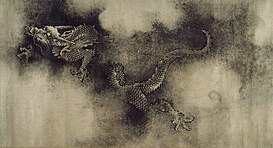














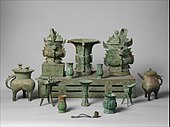



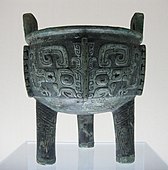

![Ritual wine server (guang); 1100 BC; Indianapolis Museum of Art.[6][7]](http://upload.wikimedia.org/wikipedia/commons/thumb/a/a4/Chinese_ritual_wine_server_%28guang%29.jpg/170px-Chinese_ritual_wine_server_%28guang%29.jpg)

